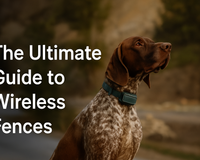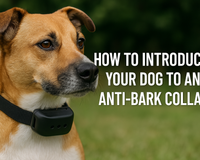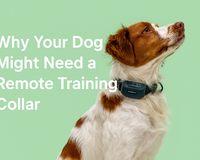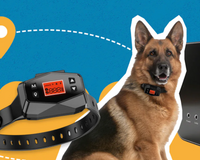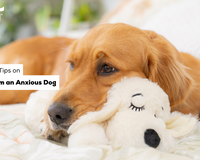Travelling with your Dog
Travelling around Australia with your dog is a once in a lifetime experience. Not only is it more fun to bring your fur-baby along with you, but you get to make some incredible memories together.
Going on a road trip with a dog takes a little more planning than a regular road trip. Below are factors you need to consider, and answers the most common questions about road tripping with a dog.
Tip 1: Make Sure Everything is Up to Date
Take the time to ensure your dog is wearing an up to date dog tag, is appropriately microchipped and isn’t missing any vaccinations.
If you’ve moved house since you’ve had your dog, it’s so easy to forget to update your information associated with them. Talk to your local council about updating your microchip information, and contact your vet about vaccinations.
If you don’t have a copy already, ask your vet for a copy of your dog’s vaccination records. We recommend saving this in your phone and keeping a copy in your glove box just in case.
And on that note, it’s best to brush up on what biosecurity rules there are for interstate travellers. Most states let you bring your pet across their borders, but they may have some different regulations for fruits, vegetables and meats. And if you plan on taking your dog to Tasmania, talk to your vet about the Hydatid treatment your dog requires to enter the state.
Tip 2: Pack the Essentials
This one sounds obvious, but we are only human and sometimes need reminders of the obvious things. Here is a checklist of the essentials you need to pack to make sure your dog stays fed, hydrated and comfortable:
- Dog food, preferably their regular breakfast and dinner
- Water bowl
- Poop bags (you’ll still need to pick up after them)
- Collar, harness and leash
- Medical records
- Grooming supplies and a towel
- Bed and blankets
- Car seat and barriers
- Favourite toys (or new ones!)
- Any medications
Tip 3: Plan Ahead
Take the time to map out your route, being conscious that you need to ensure your accommodation is dog-friendly.
There will be various caravan parks and accommodation sites that are dog and pet friendly, but doing your research prior and potentially booking will be essential.
Another thing to note, dogs aren’t allowed into most national or regional parks. So whatever route you’re planning, double-check that each park you want to visit lets you bring your furry family member.
There are a few reasons why dogs and other domestic animals aren’t allowed in national parks, but the main one is to protect native wildlife.
Whilst you’re planning your route, note down any nearby vet clinics and their contact information. Hopefully, you won’t need to use this information, but if you do thankfully, you’ll be able to access it, even if you have no internet reception.
Also for precaution take note of which vet clinics are emergency or after-hours clinics. Another handy tip is to download a dog first aid app and brush up on your doggy first aid tips before your trip.
Now, let’s get into the questions everyone asks about undertaking a road trip with a dog.

FAQ: Can Dogs go on Long Car Rides?
Your dog can go on long car rides, but you need to build up to it first. It really depends on your dog and their personality. If they are likely to get anxious or stressed, getting them used to long car rides may be a longer process than very easy going dog.
Some of the symptoms of anxiety in dogs is excessive drooling, pacing, looking a bit uncomfortable and not being able to settle. If you do notice your dog is getting anxious, try tiring them out with a long walk beforehand. This should use up some excess energy and help reduce any anxiety.
It’s best to build up their stamina in the car by taking them on increasingly longer journeys. This will help them be comfortable in the car for long distances and help them understand the feeling of motion to avoid motion sickness.
To make the experience more comfortable for your dog, and safer for you, we recommend investing in car seats, barriers, or car hammocks.
You can explore our range of eDog Dog Travel Accessories here!
FAQ: How Often Should You Stop on a Road Trip With a Dog?
The general rule of thumb is to take a 15 - 30 minute break for every 2-4 hours of driving. And offer your dog water every 2 hours.
In these breaks, stretch your legs, offer your dog some water, and give them a little snack or meal. If you can, do some exercise with your dog in these breaks so when they hop back in the car they are tired and ready to relax.
The one thing to consider is your dog’s toilet break routine. If you can stick to their usual toilet break schedule, that would be ideal, but it can be hard to do this on a road trip.
If you have a young dog, you might need to stop for more consistent potty breaks while they are still learning to hold their bladder. Elderly dogs may also need to relieve themselves more often and require two-hour intervals.
Confirm with your vet if your dog is on any medication that could alter the number of times they need to go to the bathroom.
If you are preparing your dog for a long road trip, teach them to go to the toilet on cue. This is known as eliminating. Eliminating on command will make your dog understand that home isn’t the only place they can go to the loo. Plus it’ll make toilet breaks a little quicker.
FAQ: How Long Should You Drive With a Dog?
When driving with a dog, aim for a maximum of 7 hours of driving time each day. Super long hours in a car can be too much for some dogs so capping it at 7 hours lets you cover some excellent distance whilst keeping them comfortable.
FAQ: Where Should I Put My Dog in the Car?
The best place for a dog in the car is where they can easily stand, turn around, sit, and lie down in a comfortable position. Make sure they also have enough ventilation and airflow to be comfortable.
The best spot is usually the back seat or a large open boot area. Your dog should not travel in the front passenger seat, if the airbag opened they could be seriously injured.

FAQ: What to Give a Dog Who Gets Car Sick?
Firstly, most dogs get car sick because they aren’t conditioned to do long car rides. Dogs are overwhelmed by all of the new stimuli that come with being in a moving vehicle or are so young that the inner ear isn’t fully developed, and this assists with balance.
Double-check with your vet that your dog doesn’t have a medical condition or is on medication that worsens motion sickness.
Prevent this by building up the duration of your car rides together, so they get used to more extended and different journeys. Don’t feed your dog just before your road trip together and keep the car cool and quiet.
The best thing to give your dog when they get car sick is anti-nausea medication from your vet. They may also prescribe medication that reduces vomiting or diarrhoea.
You can also try giving your dog ginger 30 minutes before you begin your road trip. Ginger has powerful anti-nausea properties and helps to soothe the digestive tract. Try giving them an eighth of a teaspoon of powdered or fresh ginger first.
FAQ: Are Road Trips Bad for Dogs?
Road trips are safe for dogs, but there are a few precautions you need to be aware of to guarantee a comfortable, safe road trip.
Never leave your dog in a car unattended, they can die very quickly from heat stress. Even if the weather is mild, never leave them locked in a vehicle.
Make sure to feed them their usual food and offer them plenty of water.
Keep your dog on a lead in new environments, so they are safe and secure. We don’t want them to be frightened or get too excited and do something unsafe.
The likelihood of the following happening is rare, but it is a factor you should know about just in case.
Sodium fluoroacetate, otherwise known as 1080 poison, is a highly toxic pesticide used in Australia to control pest animals. 1080 has no antidote, so preventing your dog from ingesting it is vital.
There are usually clear signs posted in the areas where 1080 is in use, but the safest thing you can do is invest in a muzzle or keep your dog on the leash. By muzzling your dog, they cannot ingest 1080, toxic vomit or the carcass of an animal who died from 1080 poison.
The symptoms of 1080 poisoning include restless behaviour like barking or vomiting for no reason, difficulty in breathing, convulsions, vomiting, urination or defecating uncontrollably. If you know your dog has ingested 1080, immediately take them to the nearest vet.
Have A Safe Road Trip With Your Dog!
Taking note of the following tips, and keeping in mind some safety precautions - going on a road trip with a dog around Australia is guaranteed to be a fun, memorable experience.
And if you want to keep your dog comfortable throughout your road trip together, invest in some quality dog car accessories. From booster seats to mesh pet barriers, we have it all. Contact our customer service team to find the perfect solution for you and your furry companion.







